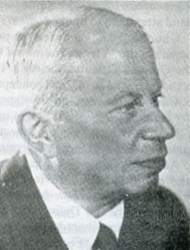
1891-1963
Helmuth von Glasenapp was a versatile scholar who wrote profusely on Indian philosophy, religion and its impact on German philosophy and literature. His books on Hinduism, Jainism and Buddhism are excellent introductions for the general reader. He promoted Indological studies in Germany.
Otto Max Helmuth von Glasenapp was born on 8.9.1891 in Berlin where his father was vice-President of the German State Bank. Glasenapp studied law for one semester before he changed over to Indology. He studied at the universities of Tuebingen, Muenchen, Berlin, and Bonn. He obtained a Ph.D. degree in 1914 for the thesis Die Lehre vom Karman in der Philosophie der Jainas ("The doctrine of karma in Jain philosophy"). Its English translation appeared in Bombay in 1942. In 1918, Glasenapp qualified as a university lecturer on the basis of his thesis Madhavas Philosophie des Vishnuglaubens ("Madhava's philosophy of Vaishnava faith"). In 1918, Glasenapp was appointed lecturer in Bonn. In 1920 he went to Berlin. From 1928 to 1945 he was professor in Koenigsberg. After World War II, he held the chair for Indology and comparative religion in the university of Tuebingen till 1959. He continued giving lectures as professor emeritus. He died on 25.6.1963 in a traffic accident.
Glasenapp travelled extensively in India and thereby gained experience of Indian culture. He described these journeys in his autobiography Meine Lebensreise, 1964. In Die indische Welt he described his personal observations on the two faces of Mother India, as he called the glory and poverty of India.
Glasenapp wrote on the three great religions of India: Der Hinduismus, 1922, Der Jainismus, 1925, and Der Buddhismus in Jndien und im Fernen Osten ("Buddhism in India and the Far East"), 1936. These three works are considered the best general surveys of their kind in Germany.
A number of Glasenapp's publications relate to philosophical subjects, e.g., Die Lehren des Vallabhacharya ("The doctrine of Vallabhacharya"), 1934, English translation, 1959. Die Philosophie der Inder appeared in 1949. In the treatise Zwei Philosophische Ramayanas ("Two Philosophical Ramayanas"), "Proceedings of the Mainz Academy", 1951, Glasenapp discussed the Yogavasistha and the Adhyatma Ramayana. In his opinion, the author of the former text was an exponent of both Vedanta and Ruddhist Vijnanavada ideas. The author of the Adhyatma Ramayana on the other hand attempted to merge Vedanta thought with Bhakti ideals.
Glasenapp studied the development of Buddhist Dharma theory in two papers in the "Vienna Journal of Oriental Studies", 1939, and "Journal of the German Oriental Society", 1938. In his opinion, the dharma theory could be traced to magical concepts in the Veda and Brahmanas, which did not distinguish between substances and qualities. In Entwicklungsstufen des indischen Denkens ("Stages in the Development of Indian Thought"), 1946, he discussed similar aspects of Indian philosophy. Der Stufenweg zum Goettlichen ("Steps to Divinity"), 1954, is a monograph on Shankara.
Among Glasenapp's works on religion, mention must be made of Brahma und Buddha, 1926, a revised edition of which appeared in 1943 as Die Religionen Indiens. Unsterblichkeit und Erloesung in den indischen Religionen ("Immortality and Deliverance in Indian Religions") appeared in 1938. Glasenapp contributed Die nichtchristlichen Religionen ("Non-Christian Religions") to the "Fischer Lexikon" I, 1954. In the same year he published Die Religionen der Menschheit, ihre Gegensetze und Uebereinstimmungen ("The Religions of Mankind, their Contrasts and Correspondences").
Glasenapp studied the influence of Indian thought on German philosophy and literature. The results were laid down in two books Kant und die Religionen des Ostens ("Kant and the Religions of the East"), 1954, and Das Indienbild deuscher Denker ("India as seen by German philosophers"), 1958. He discussed philosophers from Kant and Herder to present day thinkers like Keyserling, Schweitzer and Spengler and their attitude towards India. Also included were Christian reactions to Indian religions. The last two chapters were "Theosophy and Anthroposophy" and "Indian communities in the West".
Die Literaturen Indiens ("Indian Literatures") was first published by Glasenapp in 1929. A revised edition appeared in 1961. Glasenapp wrote the chapters on Sanskrit literature and on the literatures in modern languages in Northern India—Hindi, Bengali, etc.
On the occasion of Glasenapp's 70th birthday, a commemoration volume was presented to him: Von Buddha zu Gandhi. It contains a number of Glasenapp's papers. A bibliography was appended.
After Glasenapp's death, the German Oriental Society instituted the Glasenapp Foundation for the Promotion of Indological Studies with a sum donated by the deceased scholar for the purpose. This foundation published a compilation of his papers Ausgewaehlte Kleine Schriften in 1980. A supplement to his bibliography is also appended.